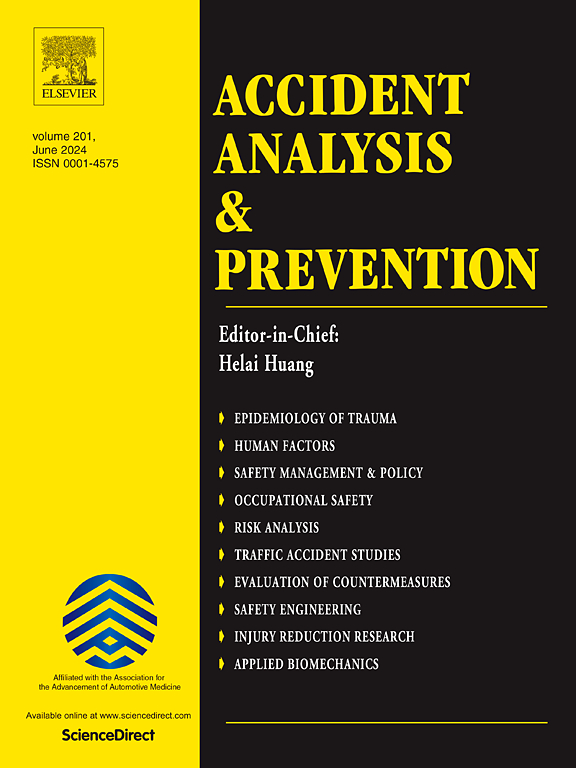Study on optimization design of guide signs in dense interchange sections of eight-lane freeway
IF 5.7
1区 工程技术
Q1 ERGONOMICS
引用次数: 0
Abstract
The eight-lane freeway resulting from reconstruction and expansion typically exhibits short distances between interchanges and a wide road section. Nonetheless, the absence of specific guidelines for the placement of guide signs in dense interchange sections of the eight-lane freeway results in inadequate design, thereby impeding drivers’ ability to read and comprehend the signs. To tackle this issue, the study employs two interchanges 2.48 km apart on the Jinan-Qingdao Freeway as a case study. Four optimization schemes for guide signs are developed based on drivers’ information requirements and compared with the current guide sign design scheme. Thirty-nine drivers were recruited to gather detailed driving behavior indicators via a driving simulation experiment. The impact of the guide sign optimization scheme on driving behavior is analyzed, and the overall effects are evaluated using the non-integer rank RSR method. This study aims to identify an optimal approach to guide sign design for dense interchange sections.
The results indicate that the impact of guide signs in dense interchange sections on drivers is primarily concentrated between the two interchanges. Specifically, the addition of a 2.5 km exit advance sign enhances drivers’ speed regulation level, the inclusion of navigation voice improves operational stability, and the presence of pavement words at exit diversion locations enhances psychological comfort for drivers. By considering the comprehensive effectiveness of each optimization scheme, it is evident that schemes 5 and 2 exhibit superior optimization effects. This suggests that providing advanced notice of exit information in dense interchange sections of eight-lane freeways is an effective measure to enhance freeway service levels and ensure driving safety. It is recommended that under the conditions of insufficient interchange spacing, the information of interchange exits should be forewarned in advance. Additionally, auxiliary navigation voice and pavement words should be employed to enhance drivers’ information perception levels, thereby mitigating the risk of missing exits due to limited reaction time. This paper serves as a significant reference for informing the optimal configuration of guide signs, thereby contributing to the meticulous development of standardized specifications.
八车道高速公路密集互通路段引导标志优化设计研究。
改建和扩建后的八车道高速公路通常具有互通式立交间距短、路面宽的特点。然而,在八车道高速公路的密集互通式立交路段,由于缺乏具体的导向标志设置指南,导致设计不足,从而影响了驾驶员阅读和理解标志的能力。为解决这一问题,本研究以济南至青岛高速公路上相距 2.48 公里的两个互通式立交为案例。根据驾驶员对信息的需求,制定了四种导向标志优化方案,并与现行的导向标志设计方案进行了比较。招募了 39 名驾驶员,通过驾驶模拟实验收集详细的驾驶行为指标。分析了导向标识优化方案对驾驶行为的影响,并使用非整数秩 RSR 方法评估了整体效果。本研究旨在确定密集互通路段导向标志设计的最优方法。结果表明,密集互通路段的导向标志对驾驶员的影响主要集中在两个互通之间。具体来说,增加 2.5 公里出口预告标志可提高驾驶员的速度调节水平,加入导航语音可提高运行稳定性,在出口分流位置设置路面文字可提高驾驶员的心理舒适度。从各优化方案的综合效果来看,方案 5 和方案 2 的优化效果更优。这表明,在八车道高速公路的密集互通路段提供出口信息预告是提高高速公路服务水平、确保行车安全的有效措施。建议在互通式立交间距不足的情况下,提前预告互通式立交出口信息。此外,应采用辅助导航语音和路面文字来提高驾驶员的信息感知水平,从而降低因反应时间有限而错过出口的风险。本文对引导标志的优化配置具有重要的参考价值,从而有助于标准化规范的细致制定。
本文章由计算机程序翻译,如有差异,请以英文原文为准。
求助全文
约1分钟内获得全文
求助全文
来源期刊

Accident; analysis and prevention
Multiple-
CiteScore
11.90
自引率
16.90%
发文量
264
审稿时长
48 days
期刊介绍:
Accident Analysis & Prevention provides wide coverage of the general areas relating to accidental injury and damage, including the pre-injury and immediate post-injury phases. Published papers deal with medical, legal, economic, educational, behavioral, theoretical or empirical aspects of transportation accidents, as well as with accidents at other sites. Selected topics within the scope of the Journal may include: studies of human, environmental and vehicular factors influencing the occurrence, type and severity of accidents and injury; the design, implementation and evaluation of countermeasures; biomechanics of impact and human tolerance limits to injury; modelling and statistical analysis of accident data; policy, planning and decision-making in safety.
 求助内容:
求助内容: 应助结果提醒方式:
应助结果提醒方式:


